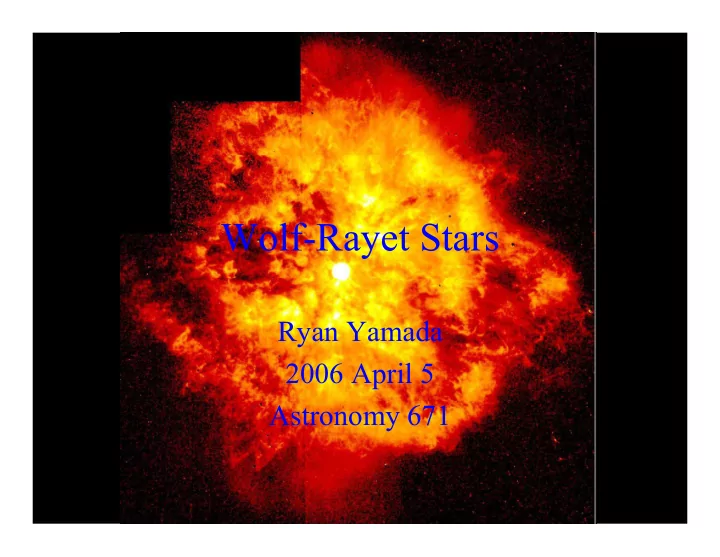

Wolf-Rayet Stars Ryan Yamada 2006 April 5 Astronomy 671
Overview • Introduction • Properties • Observations (IR and x-ray) • Models and limitations • Conclusions
What are Wolf-Rayet Stars? • Massive descendants of O-type stars – All stars with M > 40 M sun become W-Rs – Final stage before supernova – Rare (~250 in our galaxy) • Hot and luminous strong, broad (10 3 km/s) emission lines in optical due to substantial stellar wind – – T ~ 25-150K L ~ few 10 5 Lsun – • Mass Losers – dM/dt ~ 10 -4 -10 -5 M sun /yr – Driven by rad. pressure (pulsations? Magnetic-centrifugal forces?) – Terminal velocities ~ 1500/2500 km/s (IR/UV)
Evolution of a Wolf-Rayet Star • Begins as a massive O star (M > 40 M sun ) • “red” supergiant progenitor (T~ 6,000 K) • Luminosity exceeds Eddington limit; outer H layer lost • WN phase – Strong (optical) lines from He and N – Subclassified as WN3-WN9 (strong to weak) • WC phase – Lines of carbon, oxygen, and helium • WO phase – Minor subtype; strong O VI lines
Spectra of O, W-R stars
W-R stars on the HR Diagram From Moffat et al. 1989
Type Ib supernovae WO? From Daniel Kasen
Location of W-Rs • Similar distribution to O stars – n(O)/n(W-R) ~ 4 – ~ 40% found with O-type companion • Observed in other galaxies – ~few in SMC – ~100 in LMC – ~100 in M33 – ~dozens in M31 – “Wolf-Rayet” galaxies (e.g. 1 Zw 18) -> tons of these stars or different explanation for spectral features?
What are Wolf-Rayet Stars? • Massive descendants of O-type stars – All stars with M > 40 M sun become W-Rs – Final stage before supernova – Rare (~250 in our galaxy) • Hot and luminous strong, broad (10 3 km/s) emission lines in optical due to substantial stellar wind – – T ~ 25-150K L ~ few 10 5 Lsun – • Mass Losers – dM/dt ~ 10 -4 -10 -5 M sun /yr – Driven by rad. pressure (pulsations? Magnetic-centrifugal forces?) – Terminal velocities ~ 1500/2500 km/s (IR/UV)
Spectrophotometry of HD192163
What are Wolf-Rayet Stars? • Massive descendants of O-type stars – All stars with M > 40 M sun become W-Rs – Final stage before supernova – Rare (~250 in our galaxy) • Hot and luminous – strong, broad (10 3 km/s) emission lines in optical due to substantial stellar wind – T ~ 25-150K – L ~ few 10 5 Lsun • Mass Losers – dM/dt ~ 10 -4 -10 -5 M sun /yr – Driven by rad. pressure (pulsations? Magnetic-centrifugal forces?) – Terminal velocities ~ 1500/2500 km/s (IR/UV)
IUE Spectrum
ISO Spectra • Average of 7 W- R SEDs • No carbon reactions in H2 atmosphere • C 2 H 2 , while important for dust in carbon From Williams, van der stars, isn’t the Hucht, & Morris (1997) source in W-R stars
ISO Spectrum • Top: (continuum- subtracted spectrum) from WR 48a • Bottom: three possible classes of emission bands – A: HII regions, Herbig Ae/Be stars (w H II), extragalactic sources – B: Isolated Herbig Ae/Be stars, some post-AGB stars, most PNe – C: two post-AGB stars Chiar, Peeters & Tielens (2002)
Discoveries from IR Obs. • Dust inferred from shape of IR continuum – excess cannot be explained by free-free emission alone • No silicate features, but evidence of graphite grains • IR speckle interferometry puts dust shell at ~few x10 15 cm, consistent with estimated grain temperatures and emission energies • IR flux constant -> constant rate of dust formation
Discoveries from IR Obs. (cont) • Continuum emission beyond few µ m originates far from star • Shock compression in inner wind
Discoveries from X-ray • Einstein data showed WR resemble O stars (T x ~ few million degrees), small fraction of total wind • Tight relationship L x /L bol ~ 10 -7 • Inverse Compton scattering responsible for X-rays in nonthermal radio sources • Binaries -> X-ray flux due to colliding winds
Models and limitations • Most models of W-R atmospheres have assumed – (1) plane-parallel radiative transfer – (2) isotropic distribution of matter in dust – (3) core-halo structure Wolf-Rayet star BAT99-2 (ESO)
Models and limitations • Most models of W-R atmospheres have assumed – (1) plane-parallel radiative transfer – (2) isotropic distribution of matter in dust – (3) core-halo structure • Not a good idea! – (1) W-Rs are extended continuum sources; small scale height can lead to big errors in effective temperature – (2) dust is “clumpy” – (3) continuum depends sensitively on density and temperature structure in wind
Models and limitations • Wind models – Require tremendous efficiency (photons transfer ~90% momentum to gas) – Using Abbott & Lucy model, Abbott & Conti (1987) find that radiation pressure is sufficient – Hydrostatic core loses hydrogen, evolves to high T and small R, making radiation driving more efficient – This has been contested by Schmutz (1997), who claims that resonant absorption is the key to understanding winds
Summary • W-R stars are evolved O stars, and progenitors of Type Ib supernovae – (O -> WN -> WC -> WO -> Ib SN) • Massive winds are probably due to radiation pressure/absorption • Key testing ground for models of winds, supernovae, dust/cloud formation and evolution
References • Abbott, D. C., Conti, P. S. 1987, ARA&A, 25, 113 • Chiar, J.E., Peeters, E., Tielens, A. G. G. M. 2002, ApJ, 579, L91 • Moffat, A. F. J., Drissen, L., Robert, C. 1989, plbv.coll, 229 • Hamann, W.R., Koesterke, L., Wessolowski, U. 1993, A&A, 274, 397 • Schmutz, W. 1997, A&A, 321, 268 • Williams, P. M., van der Hucht, K. A., Morris, P. W. 1997, Ap&SS, 255, 169
Recommend
More recommend